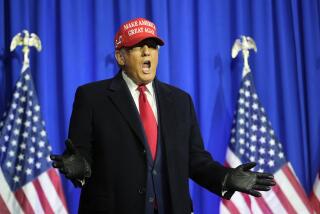Japan Defends New Trade âAction Planâ : Nakasone Claims Markets Will Be Most Open of All
TOKYO â Prime Minister Yasuhiro Nakasone said Tuesday that a three-year trade âaction programâ will make the Japanese market the most open in the world and is designed âto totally exterminate opinions that Japan is unfair.â
In a nationally televised news conference, Nakasone said the plan, approved earlier in the day by his government, ârepresents a very effective countermeasure against the critical condition which we are placed in at the current moment--namely, protectionist sentiments abroad.â
The program, aimed at countering complaints that Japan prospers by raising unfair barriers to foreign goods, will reduce or eliminate tariffs on 1,860 industrial and agricultural items and includes 87 reforms to ease certification and technical standards for importing to Japan.
Inspections Streamlined
Complicated automobile inspection procedures are to be streamlined, and Japan has agreed to accept foreign test data on products ranging from electronic equipment to pharmaceuticals.
Unlike previous packages, the one adopted Tuesday gives target dates for implementation of the provisions over a three-year period. Nakasone said a Cabinet-level committee will monitor progress of the program, the final part of the fifth âmarket-opening packageâ that he has approved since he took office in November, 1982.
The program was prompted by Japanâs record global trade surplus last year, which included a $36.9-billion surplus with the United States and a $10-billion surplus with the Common Market.
Referring to the dozens of bills introduced in the U.S. Congress to take retaliatory trade action against Japan, Nakasone said: âWe must defend the free trade system to the last. . . . We know clearly that, if we let the protectionist bills pass in the U.S. Congress, the global economy will face another recession.â
His government pulled out all of its public relations stops Tuesday, scheduling an unprecedented five news conferences on the program in addition to Nakasoneâs television speech. Nakasone hailed the program as âa great transformation in thinking toward foreign products.â
The prime minister also went on the offensive, stressing for the first time that Japanese industry is âplaying a great role in making American industry prosper, in enriching the lives of American consumers and . . . in maintaining employment in American firms.â
Nakasone said American firms obtain about $8.1 billion in parts from Japan and use them âto complete products in the United States.â
âIn this context, Japanese firms are used to make American industry prosper--Japan is an American production base,â he said.
He also cited goods that American firms order manufactured in Japan to their specifications for sale in the United States under their brand names and products that American subsidiaries in Japan sell to the United States--a total of $6 billion in Japanese exports--as contributions to American industry.
Another $5.3 billion in goods, including cameras, videocassette recorders and certain types of audio equipment that are ânot produced at allâ in the United States and have âno relation with American unemploymentâ also enrich American consumersâ lives, he said.
The three categories together, he said, account for about 30% of Japanâs exports to the United States.
He said that hidden behind the statistics of a U.S. trade deficit with Japan is âthe fact that Japanese industry is contributing to a great extent to American prosperity and to maintaining employment at American firms.â
The prime minister appealed to foreign critics âto judge calmly with full understanding of what we are doing, not merely by treating issues emotionally.â
âWe are trying to transform Japan, which has so far maintained a unique social structure as a closed nation, into an international nation,â he said. âI hope to receive sufficient understanding (of this point).â
He added that Japan is âready to listen to foreign views at any time, and, if there is something inadequate (in our policies), we will try to further improve the situation.â
Critics are likely to find shortcomings in the action program because, except for promises to buy foreign helicopters and bullet-proof sedans for the 1986 Tokyo summit conference of the seven industrialized democracies, there is nothing in the program that promises to spur imports quickly.
Nor are there any measures calling for sacrifice by either Japanese industry or agriculture.
Indeed, even a sense of urgency is missing. Many of the 87 reforms in procedures for inspections and certification of products are to be implemented âwithin three years,â and the first stage of deregulation of Japanâs financial market will not be completed until the spring of 1987.
Toshio Komoto, the Cabinet minister in charge of external economic affairs, said the program will âresult in improvements in the trade imbalanceâ but acknowledged that âefforts on the part of Japan alone are not enough.â
Nakasone, too, again urged the United States to act to reduce the strength of the dollar to make American products more competitive here.
More to Read
Sign up for Essential California
The most important California stories and recommendations in your inbox every morning.
You may occasionally receive promotional content from the Los Angeles Times.










